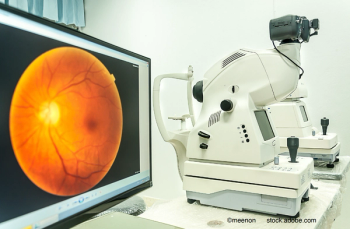
AAO 2024: Risk of posterior capsular rupture in second eye of patients with history of PCR
Abdelrahman Elhusseiny, MD, MSc, sat down with David Hutton of Ophthalmology Times to discuss his presentation on the risk of posterior capsular rupture in fellow eyes of cataract surgery at this year's American Academy of Ophthalmology meeting being held in Chicago, Illinois.
Abdelrahman Elhusseiny, MD, MSc, sat down with David Hutton of Ophthalmology Times to discuss his presentation on the risk of posterior capsular rupture in fellow eyes of cataract surgery at this year's American Academy of Ophthalmology meeting being held in Chicago, Illinois.
Video Transcript:
Editor's note: The below transcript has been lightly edited for clarity.
David Hutton:
I'm David Hutton of Ophthalmology Times. The American Academy of Ophthalmology is holding its annual meeting this year in Chicago. At that meeting, Dr Abdelrahman Elhusseiny is making a presentation titled Risk of Posterior Capsular Rupture in Fellow Eyes Cataract Surgery. First, what are the key points of your presentation?
Abdelrahman Elhusseiny, MD, MSc:
So, the main key point is that the risks and the rates of posterior capsular rupture during cataract surgery are well documented in the literature. But what we don't know is the impact of having posterior capsular rupture in one eye, on the risk of developing posterior capsular rupture in the second eye. And that is the main goal of our study, to quantify the risk of posterior capsular rupture in the second eye in patients who had the history of PCR in their first eye.
David Hutton:
What factors contribute to the increased risk of posterior capsular rupture in patients undergoing cataract surgery on their fellow eye?
Abdelrahman Elhusseiny, MD, MSc:
So. we found, we conducted the multivariate logistic regression model to adjust for confounding factors, to see if history of PCR itself is an independent risk factor of developing PCR on the other eye. And after adjusting of all confounding factors or non-confounding factors, we found that the risk is 1.7. We don't know the explanation for that, but there are 2 theories in our minds. The first one is tissue factors. Several studies showed difference in the capsular thickness and the mechanical strength variation in the pursuit capsule between different individuals. Second explanation is that patient factors, like patients with difficult positioning, uncooperative patients, deep socket are more susceptible to complications in both eyes.
David Hutton:
Are there specific surgical techniques or preoperative assessments that can help reduce the risk of posterior capsular rupture and fellow eye surgeries.
Abdelrahman Elhusseiny, MD, MSc:
So, we have, as any preop planning for cataract surgery, you take a good history from the patients, make sure that if they had the history of postmenovictrectomy that increased the risk of PCR more than 10 introvitro injections. We conducted multiple studies showing that more than 10 injections increases the risk of PCR, history of trauma, history of pseudo exfoliation, all of that. And these all are known risk factors. But what we are adding in our study is taking a history from the patient, if they had PCR in their first eye, then you know and you can counsel the patient that they are at increased risk of developing PCR in the second eye. Because, interestingly, in our study, most of the patients, about 72% of the patients, did not have an obvious risk factor for PCR intraoperatively or even during the PO planning,
David Hutton:
How do the outcomes of posterior capsular rupture in the second eye compare to the first eye?
Abdelrahman Elhusseiny, MD, MSc:
So, in terms of visual outcomes, we compared the visual outcomes of patients who had a PCR in their second eye to patients who did not have a PCR, and that visual outcome was better in the patients who did not have PCR. But comparing PCR in the second eye versus PCR in the first eye was compatible.
David Hutton:
What are the key considerations for managing these complications?
Abdelrahman Elhusseiny, MD, MSc:
So, the main thing is preop planning, counseling. Make sure that you have what you need in the room. You know, get comfortable with identifying the risk factors, identifying the capsular rupture when it first happens. You can use kenalog and the usual technique for managing, pursue capsular rupture. Kenalog, assess the capsular support, good anterior vitrectomy and evaluate if you need to proceed with the surgery with implanting an IOL or refer to a retina specialist based on the situation, based on the site and the size of the rupture.
David Hutton:
Given the potential risks, how should ophthalmologists counsel patients with a history of posterior capsular rupture in 1 eye when planning surgery for the second eye,
Abdelrahman Elhusseiny, MD, MSc:
I think the first thing is to try to dig deep into the operative note for the patient to see if there is any red flags, like uncooperative patients or patients who are anxious during the surgery ... try to talk to the patient about how the surgical procedure goes. If the patient is completely uncooperative or have medical problem like coughing or severe COPD, you can talk to the anesthesia team to see, how can you make this patient as comfortable as you can. That's one thing. The other thing is, cancel the patient ... given the history of the first eye, there's still an increased risk in the second eye.
Newsletter
Keep your retina practice on the forefront—subscribe for expert analysis and emerging trends in retinal disease management.
















































